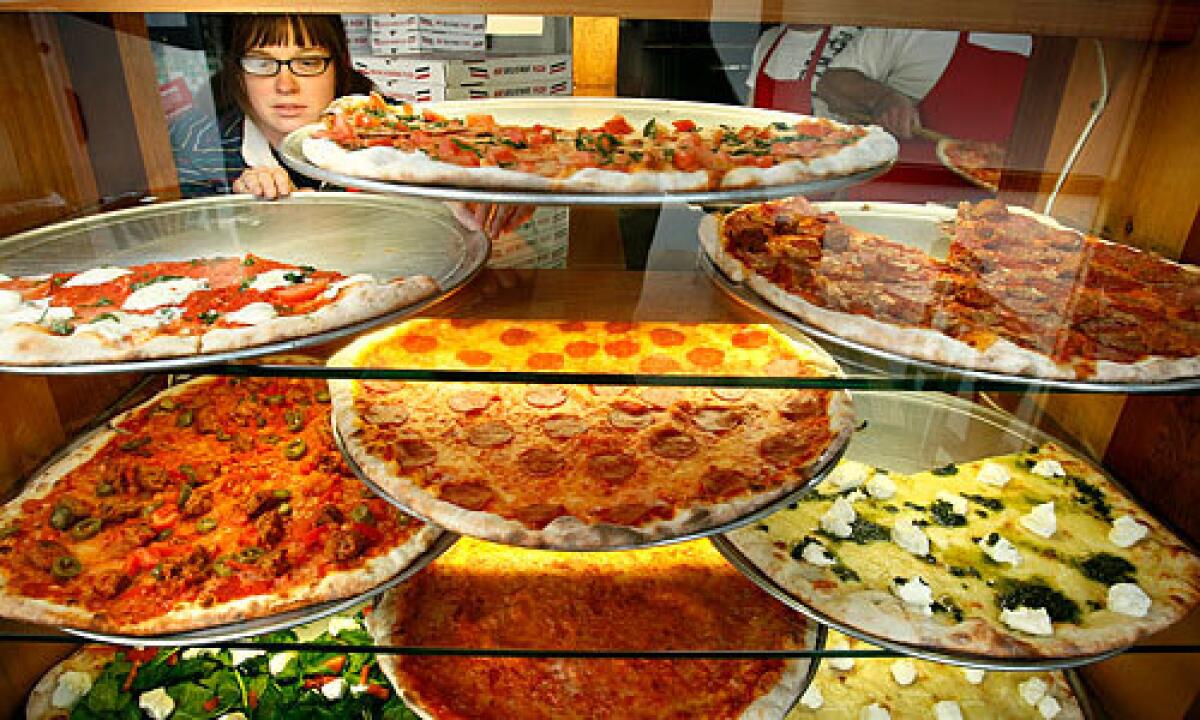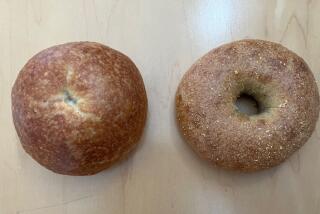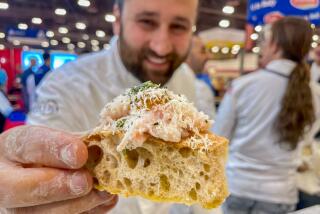New York-style pizza: what it means

When I moved from Los Angeles to Manhattan, one of the first things I learned was that I had a lot to learn about pizza. One doesn’t stand in line but on line; it’s not “for here or to go” but “to stay or take away”; and don’t order “a piece of pizza” -- it’s “a slice.”
But those were mere details: True pizza enlightenment didn’t come until I was kicked out of my semi-illegal Lower East Side sublet and ended up living in Brooklyn. A friend wise in the ways of pizza led me on a pilgrimage to Di Fara, where you could get a slice of owner Domenico DeMarco’s perfection, which included fresh mozzarella di bufala and a sprinkling of Grana Padano cheese at the end of baking. And I stood on line at the base of the Brooklyn Bridge for Patsy Grimaldi’s pies, the tops of the bubbles at the edge of the crust crisp-charred in the coal-fired brick oven.
Moving back to L.A. from Brooklyn can leave a (pizza-size) hole in one’s heart, but an influx of Big Apple pizza has gained some momentum since Joe Vitale of Joe’s Pizza in New York decided to open a Santa Monica outpost (no, despite what seems to have become urban legend, the dough isn’t made with water from New York).
The proliferation of those turning out pies in the New York style has continued, with Verrazano’s on La Brea Avenue and Garage Pizza in Silver Lake. Pizza by the slice is now downright common in Southern California. Most recently, New York import Two Boots has landed in Echo Park.
So this is the right time to revisit the perennial question: What is New York pizza? Well, it’s not Two Boots. Because who ever heard of a New York pizza with cornmeal crust?
Here are the basics:
The crust: Everybody knows New York pizza, like its Neapolitan forebear, is thin. It should be less than one-fourth-inch thick until you get about 1 to 1 1/2 inches from the edge; this area should be thicker, with good hole structure, i.e., bubbles. (In case anyone was wondering, this is one of the factors that eliminates Eagle Rock favorite Casa Bianca as New York pizza; it’s flat all the way to its perimeter.)
Unlike Neapolitan pizza, New York pizza is large. According to Jeffrey Steingarten in the chapter titled “Perfect Pizza” in his book “It Must Have Been Something I Ate,” it’s 14 to 18 inches in diameter. At Vito’s Pizza in West Hollywood, menu says “the pizza comes in one size only, BIG!” (It’s 18 inches.)
Steingarten also helpfully describes the crust in cross-section: “The bottom 1/32 -inch is crisp and very nearly charred. The next 3/32 -inch is made up of dense, delicious, chewy bread. And the top 1/16 -inch is slightly gooey.” In short, it’s crisp yet pliable -- New Yorkers do fold their slices, but it shouldn’t be soggy.
Should it be baked in a wood- or coal-fired oven, as opposed to a gas-powered deck oven? The expected aficionado’s answer would be yes, to provide the most heat the fastest, and that’s how New York’s first pizzas were made -- by Gennaro Lombardi at the turn of the 20th century and the pizzaiolo legends he trained at his oven.
And if the edge of the crust at Nicky D’s in Silver Lake is any indication, it’s the way to go -- crisp and smoky flavored, the bubbles are extra dark, some of them so blasted by the heat that they are already shattered when the pizza arrives at the table.
Still, those amazing pizzas at Di Fara came from gas deck ovens. And at Vito’s in West Hollywood, which is outfitted with customized deck ovens (the stones for which were brought from Italy), pie man Antonio Di Donato gets a crisp, thin crust, golden brown with some occasional dark spots. “They give the pizza character,” says Di Donato, whose cousin Vito Di Donato prepares the dough every day starting at 5 a.m. (nobody, including Antonio, gets to see what he’s doing, “so his secrets never slip out”).
“There’s a lot of trial and error that goes into making the best pizza with the tools you’ve got at hand,” says Antonio. “It’s a dynamic formula. Everything has to be taken into consideration, from the weather, the moisture in the air, the volume of business -- the more you open that door, the more heat you draw from the stones. You have to adjust according to the environment.”
As for the sauce, Ed Levine, in “Pizza: A Slice of Heaven,” spells it out: “The best pizza sauces are made with uncooked canned tomatoes, from either California or Italy, that have been strained and seasoned with salt and maybe some oregano.” It is not a slow-cooked sauce such as for pasta.
The cheese, of course, is mozzarella. A lot of New York pizza places use Grande Cheese, whose “East Coast Blend” is half part-skim mozzarella and half whole-milk mozzarella.
Nick DeMarinis, owner of Nicky D’s, uses Grande too. “It doesn’t burn in my oven. I like the full whole-milk better. I think it’s healthier,” he joked.
DeMarinis, who hails from Queens, has another point he’d like to make about New York pizza. “A lot of places pop up here and there and say ‘New York-style pizza’ and they’re from Buffalo. New York-style pizza means New York City-style pizza. You have to be working in New York City to learn to make New York-style pizza.”
What if someone happens to be from Buffalo and makes it exactly the way he does?
“They’re still not doing it right. Trust me. Or they might be, but it’s still not 100% on.”
What if they’re from Jersey?
He says: “Not really. We got a thing about that.”
More to Read
Eat your way across L.A.
Get our weekly Tasting Notes newsletter for reviews, news and more.
You may occasionally receive promotional content from the Los Angeles Times.







